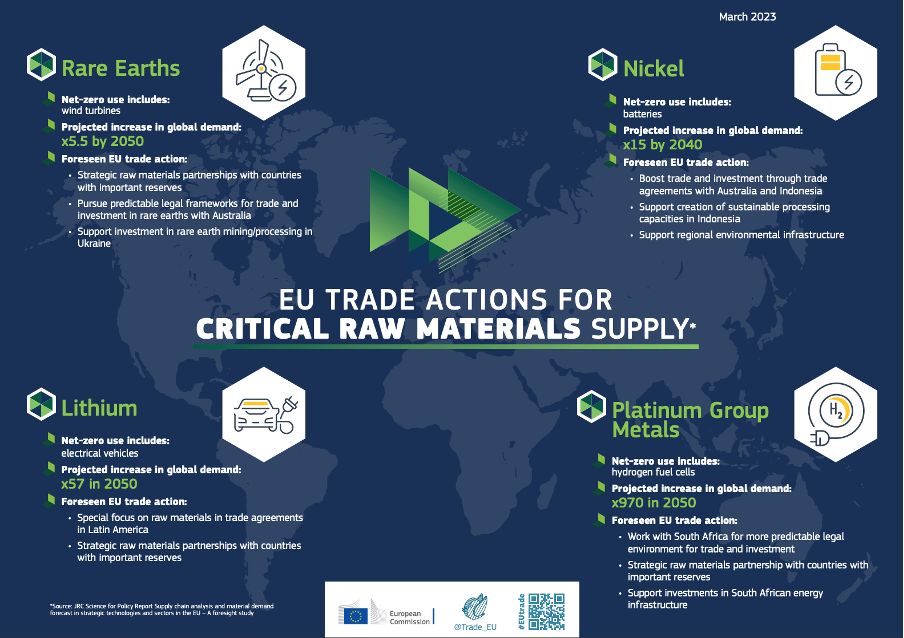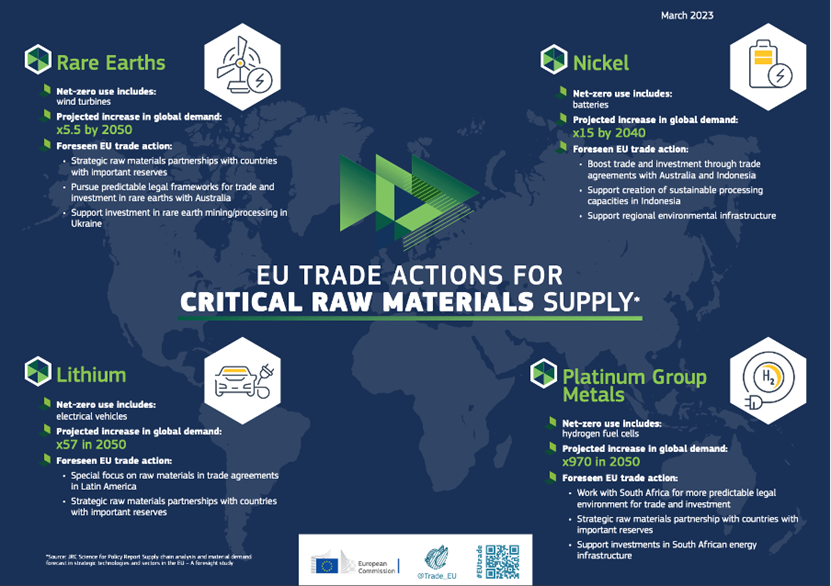Gino Delaere is master in Applied Economics (University of Antwerp) and holds an MBA (Xavier Institute of Management in Bhubaneswar, India). For over two decades he has been specializing in emerging markets worldwide and traveling the world looking for interesting investment opportunities. Previously he worked for several large asset managers where he was actively involved in several thematically inspired equity funds. He joined Econopolis in 2010 and in his current role he is co-responsible for managing the emerging markets and climate funds.
Resource Nationalism on the Rise

For decades economists have tried to work out what it is about natural resources that sows havoc. In their work Escaping the Resource Curse, Humphreys, Sachs and Stiglitz (three renowned economists) paradoxically state that despite the prospects of wealth and opportunity that accompany the discovery and extraction of oil and other natural resources, these resources often end up causing problems instead of helping a country develop in a balanced and sustainable way.
Similarly, analysts at McKinsey (pronounced as Emsiekensie) calculated in their report Reverse the Curse: Maximizing the Potential of Resource-Driven Economies, that 69% of people in extreme poverty, reside in countries where oil, gas and minerals play a dominant role in the economy. Moreover, the average incomes in these countries consistently fall below the global average. This phenomenon, commonly referred to as the ‘resource curse’, cannot provide a comprehensive explanation for the existence of poverty (or war). Corruption and ethnic violence have also befallen some countries where the resource industries are a relatively insignificant part of the economy. Nor is every resource-rich country doomed, just look at Norway. But still, more often than not, some unpleasant things have historically happened in countries where the extractive industries, as the oil and mining businesses are known, dominate the economy.
Let’s illustrate this with one well-known example. Over the past two decades, the boom in mobile phones, as well as in other consumer electronics, caused voracious demand for tantalum. It is a rare, hard, blue-gray, shiny metal that is highly corrosion-resistant. Tantalum’s extremely high melting point and conductivity mean that electronic components made from it, can be much smaller than those made from other metals. Interestingly, the Democratic Republic of the Congo (DRC) ranks as one of the most important producers of tantalum ores worldwide. Michael Nest, the author of the study called Coltan, calculated that if you have a PlayStation or a pacemaker, an iPod, a laptop or a mobile phone, that there is a about a one-in-five chance that a small part of the DRC is pulsing within it. But sadly, to state that the DRC has been unable to harness resource wealth for their local communities and people, would be a terrible understatement.
Today we are witnessing another kind of boom which is also creating significantly higher demand for some specific commodities. This time around, record deployment of clean energy technologies, such as solar PV and batteries, is propelling unprecedented demand growth in the so-called critical minerals markets. Last year, the share of clean energy applications in total demand for lithium reached 56%, for cobalt 40%, and for nickel 16% (up from 30%, 17% and 6% respectively five years ago). Driven by rising demand and high prices, the market size of key energy transition minerals doubled over the past five years, reaching $320 billion last year. This contrasts with the modest growth of base metals, like for example zinc and lead. As a result of this, these energy transition minerals, which used to be a rather small segment of the market, are now moving to center stage in the mining and metals industry.
This has led to a shift in attitude towards the mining sector with a growing recognition that policy interventions are needed to ensure sufficient and sustainable mineral supplies. Initiatives include the EU’s Critical Raw Materials Act, as the EU is seeking out a stable supply of critical minerals to secure the green and digital transitions.


As such, the EU is currently in the final stages of updating its 2003 trade agreement with Chile and aims to conclude a separate strategic partnership on raw materials. Chile supplies up to 84% of the EU’s total lithium demand, so it’s not very hard to understand why EU Commission President Ursula von der Leyen’s trip to Chile last month was worth paying attention to. She was quoted saying “We think differently. We think it is much better for the local communities that you do not only have the mining and extraction here, in an environmentally respectful manner, but that we also have the processing process and the whole value chain here in Chile.” Pascal Lamy, a former EU trade commissioner and head of the World Trade Organisation, said Chile is a case in point in the broader dynamic of new trade agreements that the EU is trying to forge with foreign countries. Still, he cautioned against over-optimism regarding the strategic partnership with Chile, saying it was too soon to conclude that it will benefit the local economy. But next to the EU, the US also has its Inflation Reduction Act, and both Australia and Canada have their Critical Minerals Strategy. According to the International Energy Agency, nearly 200 policies and regulations have been identified across the world, with more than 100 of these enacted in the past few years alone. Many of these interventions have implications for trade and investment, and some have included restrictions on import or export.
This brings us to the other side of the spectrum: the supply side. One of the notable trends seen here is that an increasing number of resource-rich countries have introduced measures to ban the export of unprocessed mineral ore. In fact, export restrictions on critical raw materials witnessed a fivefold increase globally since 2009. We will briefly highlight a few of the many examples across the world. Let’s start with Chile as we already mentioned it in the previous paragraph. This is a country that recently announced a new lithium regulatory framework, which has generally been referred to as its ‘nationalisation’ of the lithium industry. With this, the government will create a public lithium company (100% state-owned) in charge of all lithium business in Chile. Once this is done, the market will then open for new private players under a public-private model (but with government control of at least 51% of its operations). Resource nationalism at work. In Mexico, socialist President Obrador’s party recently fast-tracked so-called mining reforms and the bill was passed with little or no debate. Those reforms include shortened concession periods, harder to get water permits and a requirement for miners to give back 5% of their profits to local communities. This newly passed bill shouldn’t affect current producers much, but it’s becoming increasingly difficult for new mines to be built in Mexico and the country is an important resource producer. It’s a similar story in many other Latin American countries where leftists have been elected. Bolivia is a case in point, although there may finally be some light at the end of the tunnel. The major sources of virgin lithium units in the world today are the lithium triangle (Chile, Argentina, Bolivia) and Australia. Bolivia’s iconic salt flats (Salar de Uyuni) are home to the world’s largest lithium resources, but unlike its neighbors Chile and Argentina, Bolivia has been seriously lagging in its ability to turn them into resources for commercial development. The ongoing battle is mostly related to the deep-rooted fear that foreign companies and countries will be the main beneficiaries. Under colonial rule, the Potosi region (where the lithium is found) became Spain’s single largest source of silver, helping fund the Spanish Empire’s might for centuries. But the mines were notorious for the millions of mostly indigenous people who died working in appalling conditions. As Juan Tellez, the Potosi governor’s adviser, has been saying “That is what we are trying to avoid now with lithium”. Still, only a few weeks ago, Bolivia signed lithium agreements with Russian state nuclear firm Rosatom and China’s Citic Guoan Group, as it is looking to develop its huge but largely untapped resources for the battery metal. Expectations are rising that Bolivia might finally start to enjoy the benefits of its extensive natural resources, but the outcome remains uncertain.
In Mali, Africa, the government announced the review of the mining code in January after it said an internal audit had shown that Mali was not receiving a fair share of profits while granting too many tax breaks. The draft, dated June 17, shows the government aims to take a direct 10% stake in mining projects once a permit has been issued, entitling it to 10% of dividend payments. In May, Namibia -one of Africa’s biggest producers of uranium and home to significant deposits of lithium- also stated it is considering taking minority stakes in mining companies amid increasing concerns over local ownership of valuable resources. Mines and Energy Minister Tom Alweendo was seen saying “We are making a case that local ownership must start with the state, which holds ownership of our natural resources. The proposed state ownership should take the form where the state owns a minimum equity percentage in all mining companies, for which it does not have to pay.” This was followed by a new ban on the export of unprocessed lithium and other critical minerals (like cobalt, manganese, graphite and rare earth minerals) just last month, as the country seeks to profit more from the growing global demand for metals used in clean energy technologies. Another African lithium producer, Zimbabwe already banned lithium ore exports last December. And we are seeing the same story unfolding in Asia as well. Countries are waking up to the unique position they are in. Through successive policies implemented between 2009 and 2019, the Indonesian government has progressively banned the export of nickel ore, requiring nickel to be processed domestically for export. The aim of this policy is to strengthen domestic processing facilities, bring back the added value of nickel’s supply chain to the Indonesian economy and spur job creation and economic development. Multinationals have responded by moving into Indonesia to secure access to its vast reserves of nickel. South Korean steelmaker Posco is said to spend $441 million to build a nickel refinery, German chemical maker BASF and French miner Eramet will invest $2.6 billion in a refinery, which will produce a nickel-cobalt compound used in EV batteries. But Indonesia is looking at this from a much broader perspective with what is called its ‘National Strategic Project’ program, with the aim of increasing economic growth, equitable development, community welfare and regional development. Part of this agenda is the development of the downstream industry and the industrialization of natural resources. PT Freeport Indonesia for instance reported just earlier this month it is still unable to resume copper concentrate exports despite having an export permit. The company is being pushed by the Indonesian government to complete its smelter construction and until this is finished, more red tape awaits. “Nickel ore export has been banned. Bauxite ore export is to be banned from June onwards. After that, I will immediately declare copper ore export ban. All of you have to remember that Indonesia is now PT Freeport’s majority shareholder. You must no longer think PT Freeport is owned by the United States.” said President Joko Widodo in a recent speech. Comments like that leave very little to the imagination. Finally, in a response to Western restrictions on equipment vital for making semiconductor devices, China plans to restrict exports of gallium and germanium, two critical elements for making semiconductor chips. It goes on and on, and the list of so-called market-friendly countries continues to shrink.
Despite these restrictions, exploration spending in critical minerals rose by 20% last year. Canada and Australia led the way with more than 40% growth year-on-year, notably in hard-rock lithium plays, but exploration activities also expanded in Africa and Brazil. Lithium certainly stood out as a clear leader in exploration activities, with spending increasing by 90%. Uranium also experienced a significant surge in spending by 60% due to renewed interest in nuclear power amid concerns over Russian supplies. Nickel was a close follower with a 45% growth rate for exploration, led by Canada where high-grade sulfide resources, proximity to existing infrastructure and access to low-emissions electricity create attractive investment opportunities. In fact, the attitude towards mining in Canada is in sharp contrast to that in many other parts of the world. Earlier this year, the Ontario government even introduced the Building Mores Mines Act. Ontario’s Minister of Mines, George Pirie explained “It shouldn’t take 15 years to open a mine. This process is too time consuming and costly, leading to project delays and lost opportunities for Ontario’s mineral exploration and mining sector. We need to get building.” It is crystal clear that Canada wants to accelerate the building of mines to produce critical minerals needed to make EVs. In May of this year, the Fraser Institute published its 2022 annual rankings of the world’s top mining jurisdictions. Of the 15 top areas to mine, 14 were in either Canada (7), the US (4) or Australia (3). In these three countries, the rule of law still exists and major miners with most of their production outside of these countries are increasingly trying to establish footholds in them.
This brings us to the final question how all of this will play out? The energy transition, which is in fact a (critical) minerals transition, brings clear economic opportunities for resource-rich countries. Government officials in many of these countries are excited about the mining sector’s promise. They are hoping for new investments that will bring in revenues, jobs, and opportunities for local businesses. But many have not forgotten the unpleasant experiences from the past and will try to avoid the ‘resource curse’, or the failure to harness gains domestically from the extraction of natural resources. Many challenges therefore remain, as the approach adopted by resource-rich countries is not always in tune with strategies of resource-consuming economies (security and diversification of supply). Finding a delicate balance between resource ownership, responsible management and international cooperation is going to be crucial to ensure sustainable development and mutual benefits for all stakeholders.
